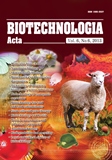ISSN 2410-776X (Online),
ISSN 2410-7751 (Print)

"Biotechnologia Acta" v. 6, no 6, 2013
https://doi.org/10.15407/biotech6.06.105
Р. 105-112, Bibliography 12, Ukrainian.
Universal Decimal classification: 579.222
MUTANT STRAIN of Bacillus subtilis IFBG MC-1 WITH INCREASED TRYPTOPHAN SYNTHESIS
A. F. Tkachenko, N. E. Beyko, A. I. Khomenko, O. O. Tigunova, S. E. Priyomov, S. M. Shulga
SO «Institute of Food Biotechnology and Genomics» of National Academy of Sciences of Ukraine, Kyiv
Scientific research of essential amino acids biotechnology is directed both to create optimum conditions for producer’s cultivation and economically viable raw materials selection for these technologies, so as breeding the more productive microorganisms strains capable of extracellular producing amino acids.
For successful microbial synthesis it is necessary to have an excellent crop’s metabolism knowledge and ensure that the composition of growth medium have no repressing substances.
Bacterial cultures from «Collection microorganism’s stains and plants line for food and agriculture biotechnology» from Institute of Food Biotechnology and Genomics of National Academy of Sciences of Ukraine have been studied. Tryptophan producer Bacillus subtilis have been selected, which accumulated the greatest amount of this amino acid in the cultivation liquid. The optimal culture producer conditions were selected. Using selection methods, namely mutagenesis with UV irradiation and sequential stepwise selection, mutant strain Bacillus subtilis IFBG MC-1 were obtained which produced nearly 50% more tryptophan (13.9 g/l) than the parent strain.
Key words: Bacillus subtilis, biosynthesis, tryptophan, stain.
© Palladin Institute of Biochemistry of National Academy of Sciences of Ukraine, 2013
References
1. Umbarger H. E. Amino acid biosynthesis and its regulation. Annu. Rev. Biochem. 1978, V. 47, P. 533–606.
2. Lessard P., Guillouet A. S., Willis L. B., Sinskey A. J. Corynebacteria, brevibacteria. The encyclopedia of bioprocess technology: fermentation, biocatalysis and bioseparation. 1999, 2 (Y), 729–740.
3. Ribeiro M. D. M., Alves S. S., Regalo Da Fonseca M. M. Kinetics of L-Tryptophan Production from Indole and L-Serine Catalyzed by Whole Cells with Tryptophanase Activity. J. Biosci. Biotechnol. 2004, 97 (5), 289–293.
4. Tigunova E. A., Tkachenko A. F., Beiko N. E. Influence of the components of the fermentation medium in the biosynthesis of tryptophan. Articles VI Mos. Internat. Congress "Biotechnology: state and prospects of development", Moscow, Russia, 21–25 March 2011. P. 376–377. (In Russian).
5. Marzieh D. S., Fooladi J., Seyedeh Z. M.-N. L-tryptophan production by Escherichia coli in the presence of Iranian can molasses. JPS. 2010, 1 (2), 19–24.
6. Koch A. K., Reiser I. Kappeli O., Fiechter A. Genettic construction of lactose-utilizing strains of Pseudomonas aeruginosa and their application in biosurfactant production. Nat. Biotechnol. 1988, V. 6, P. 1335–1339.
7. Glazunov A. V., Akishina R. I., Serebrennikov V. M. The study of the periodic cultivation of Bacillus subtillus - producer of riboflavin. Biotekhnologiya. 2001, N 4, P. 85–91. (In Russian).
8. Arbige M. V., Bulthius B. A., Schultz J., Crabb D. Fermentation of Bacillus: Bacillus subtilis and other gram-positive bacteria: biochemistry, physiology and molecular genetic. D. C.: American Society of Microbiology. 1993, P. 871–895.
9. Priest F. G. Production from bacillus. Handbooks of Biotechnology. 1989, N 4, P. 293–315.
10. Fedorenko V. O., Ostash B. O., Gonchar M. V., Rebets Yu. V. Large workshop on genetics, genetic engineering and biotechnology analysis of microorganisms. Teach. A manual for biological faculties of universities. Lviv: Publishing center of Franko Lviv National University. 2007, 280 p. (In Ukrainian).
11. Tigunova E. A., Tkachenko A. F., Beiko N. E. Effect on the environment components эnzymatycheskoy byosyntez tryptophan. Biotekhnologiia. 2011, 4 (3), 51–55. (In Russian).
12. Detsch C., Stulke J. Ammonium utilization in Bacillus subtilis: transport and regulatory functions of NrgA and NrgB. Microbiology (UK). 2003, V. 149, P. 3289–3297.
https://doi.org/10.1099/mic.0.26512-0

